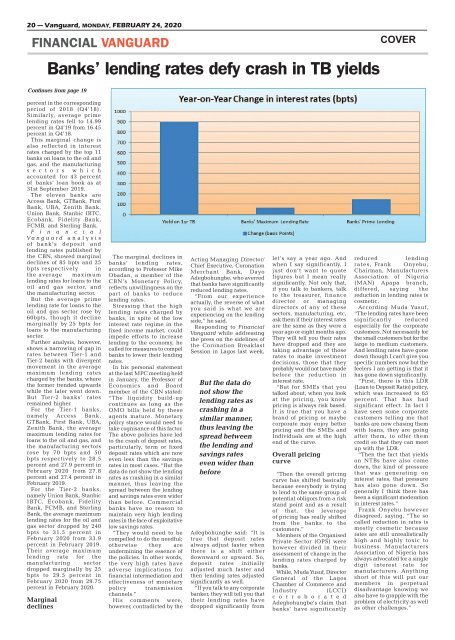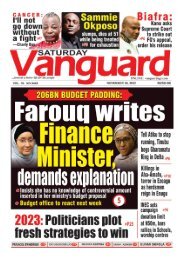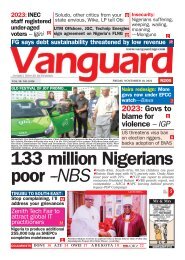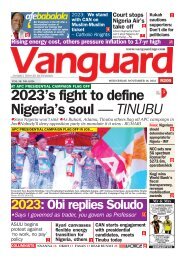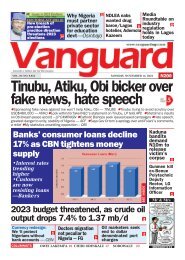You also want an ePaper? Increase the reach of your titles
YUMPU automatically turns print PDFs into web optimized ePapers that Google loves.
20 — Vanguard, MONDAY, FEBRUARY 24, 2020<br />
FINANCIAL VANGUARD<br />
Banks’ lending rates defy crash in TB yields<br />
Continues from page 19<br />
COVER<br />
percent in the corresponding<br />
period of 2018 (Q4’18).<br />
Similarly, average prime<br />
lending rates fell to 14.99<br />
percent in Q4’19 from 16.45<br />
percent in Q4’18.<br />
This marginal change is<br />
also reflected in interest<br />
rates charged by the top 11<br />
banks on loans to the oil and<br />
gas, and the manufacturing<br />
s e c t o r s w h i c h<br />
accounted for 43 percent<br />
of banks’ loan book as at<br />
31st September 2019.<br />
The eleven banks are<br />
Access Bank, GTBank, First<br />
Bank, UBA, Zenith Bank,<br />
Union Bank, Stanbic IBTC,<br />
Ecobank, Fidelity Bank,<br />
FCMB, and Sterling Bank.<br />
F i n a n c i a l<br />
Vanguard analysis<br />
of bank’s deposit and<br />
lending rates published by<br />
the CBN, showed marginal<br />
declines of 85 bpts and 25<br />
bpts respectively in<br />
the average maximum<br />
lending rates for loans to the<br />
oil and gas sector, and<br />
the manufacturing sector.<br />
But the average prime<br />
lending rate for loans to the<br />
oil and gas sector rose by<br />
60bpts, though it decline<br />
marginally by 25 bpts for<br />
loans to the manufacturing<br />
sector.<br />
Further analysis, however,<br />
shows a narrowing of gap in<br />
rates between Tier-1 and<br />
Tier-2 banks with divergent<br />
movement in the average<br />
maximum lending rates<br />
charged by the banks, where<br />
the former trended upwards<br />
while the later went down.<br />
But Tier-2 banks’ rates<br />
remained higher.<br />
For the Tier-1 banks,<br />
namely Access Bank,<br />
GTBank, First Bank, UBA,<br />
Zenith Bank, the average<br />
maximum lending rates for<br />
loans to the oil and gas, and<br />
the manufacturing sectors<br />
rose by 70 bpts and 50<br />
bpts respectively to 28.5<br />
percent and 27.9 percent in<br />
February 2020 from 27.8<br />
percent and 27.4 percent in<br />
February 2019.<br />
For the Tier-2 banks,<br />
namely Union Bank, Stanbic<br />
IBTC, Ecobank, Fidelity<br />
Bank, FCMB, and Sterling<br />
Bank, the average maximum<br />
lending rates for the oil and<br />
gas sector dropped by 240<br />
bpts to 31.5 percent in<br />
February 2020 from 33.9<br />
percent in February 2019.<br />
Their average maximum<br />
lending rate for the<br />
manufacturing sector<br />
dropped marginally by 25<br />
bpts to 29.5 percent in<br />
February 2020 from 29.75<br />
percent in February 2020.<br />
Marginal<br />
declines<br />
The marginal declines in<br />
banks’ lending rates,<br />
according to Professor Mike<br />
Obadan, a member of the<br />
CBN’s Monetary Policy,<br />
reflects unwillingness on the<br />
part of banks to reduce<br />
lending rates.<br />
Stressing that the high<br />
lending rates charged by<br />
banks, in spite of the low<br />
interest rate regime in the<br />
fixed income market, could<br />
impede efforts to increase<br />
lending to the economy, he<br />
called for measures to compel<br />
banks to lower their lending<br />
rates.<br />
In his personal statement<br />
at the last MPC meeting held<br />
in January, the Professor of<br />
Economics and Board<br />
member of the CBN stated:<br />
“The liquidity build-up<br />
continues as long as the<br />
OMO bills held by these<br />
agents mature. Monetary<br />
policy stance would need to<br />
take cognisance of this factor.<br />
The above policies have led<br />
to the crash of deposit rates,<br />
particularly, term or fixed<br />
deposit rates which are now<br />
even less than the savings<br />
rates in most cases. “But the<br />
data do not show the lending<br />
rates as crashing in a similar<br />
manner, thus leaving the<br />
spread between the lending<br />
and savings rates even wider<br />
than before. Commercial<br />
banks have no reason to<br />
maintain very high lending<br />
rates in the face of exploitative<br />
low savings rates.<br />
“They would need to be<br />
compelled to do the needful;<br />
otherwise they are<br />
undermining the essence of<br />
the policies. In other words,<br />
the very high rates have<br />
adverse implications for<br />
financial intermediation and<br />
effectiveness of monetary<br />
policy transmission<br />
channels.”<br />
His comments were,<br />
however, contradicted by the<br />
Acting Managing Director/<br />
Chief Executive, Coronation<br />
Merchant Bank, Dayo<br />
Adegbohungbe, who averred<br />
that banks have significantly<br />
reduced lending rates.<br />
“From our experience<br />
actually, the reverse of what<br />
you said is what we are<br />
experiencing on the lending<br />
side,” he said.<br />
Responding to Financial<br />
Vanguard while addressing<br />
the press on the sidelines of<br />
the Coronation Breakfast<br />
Session in Lagos last week,<br />
But the data do<br />
not show the<br />
lending rates as<br />
crashing in a<br />
similar manner,<br />
thus leaving the<br />
spread between<br />
the lending and<br />
savings rates<br />
even wider than<br />
before<br />
Adegbohungbe said: “It is<br />
true that deposit rates<br />
always adjust faster when<br />
there is a shift either<br />
downward or upward. So,<br />
deposit rates initially<br />
adjusted much faster and<br />
then lending rates adjusted<br />
significantly as well.<br />
“If you talk to any corporate<br />
banker, they will tell you that<br />
their lending rates have<br />
dropped significantly from<br />
let’s say a year ago. And<br />
when I say significantly, I<br />
just don’t want to quote<br />
figures but I mean really<br />
significantly. Not only that,<br />
if you talk to bankers, talk<br />
to the treasurer, finance<br />
director or managing<br />
directors of any of these<br />
sectors, manufacturing, etc,<br />
ask them if their interest rates<br />
are the same as they were a<br />
year ago or eight months ago.<br />
They will tell you their rates<br />
have dropped and they are<br />
taking advantage of those<br />
rates to make investment<br />
decisions, those that they<br />
probably would not have made<br />
before the reduction in<br />
interest rate.<br />
“But for SMEs that you<br />
talked about, when you look<br />
at the pricing, you know<br />
pricing is always risk based.<br />
It is true that you have a<br />
brand of pricing or maybe<br />
corporate may enjoy better<br />
pricing and the SMEs and<br />
Individuals are at the high<br />
end of the curve.<br />
Overall pricing<br />
curve<br />
“Then the overall pricing<br />
curve has shifted basically<br />
because everybody is trying<br />
to lend to the same group of<br />
potential obligors from a risk<br />
stand point and as a result<br />
of that, the leverage<br />
of pricing has really shifted<br />
from the banks to the<br />
customers.”<br />
Members of the Organised<br />
Private Sector (OPS) were<br />
however divided in their<br />
assessment of change in the<br />
lending rates charged by<br />
banks.<br />
While, Muda Yusuf, Director<br />
General of the Lagos<br />
Chamber of Commerce and<br />
Industry<br />
(LCCI)<br />
c o r r o b o r a t e d<br />
Adegbohungbe’s claim that<br />
banks’ have significantly<br />
reduced<br />
lending<br />
rates, Frank Onyebu,<br />
Chairman, Manufacturers<br />
Association of Nigeria<br />
(MAN) Apapa branch,<br />
differed, saying the<br />
reduction in lending rates is<br />
cosmetic.<br />
According Muda Yusuf,<br />
“The lending rates have been<br />
significantly reduced<br />
especially for the corporate<br />
customers. Not necessarily for<br />
the small customers but for the<br />
large to medium customers.<br />
And lending rates have gone<br />
down though I can't give you<br />
specific numbers now but the<br />
feelers I am getting is that it<br />
has gone down significantly.<br />
“First, there is this LDR<br />
(Loan to Deposit Ratio) policy,<br />
which was increased to 65<br />
percent. That has had<br />
significant effect. In fact I<br />
have seen some corporate<br />
customers telling me that<br />
banks are now chasing them<br />
with loans, they are going<br />
after them, to offer them<br />
credit so that they can meet<br />
up with the LDR.<br />
“Then the fact that yields<br />
on NTBs have also come<br />
down, the kind of pressure<br />
that was generating on<br />
interest rates, that pressure<br />
has also gone down. So<br />
generally I think there has<br />
been a significant moderation<br />
in interest rates.”<br />
Frank Onyebu however<br />
disagreed, saying, “The so<br />
called reduction in rates is<br />
mostly cosmetic because<br />
rates are still unrealistically<br />
high and highly toxic to<br />
business. Manufacturers<br />
Association of Nigeria has<br />
always advocated for a single<br />
digit interest rate for<br />
manufacturers. Anything<br />
short of this will put our<br />
members in perpetual<br />
disadvantage knowing we<br />
also have to grapple with the<br />
problem of electricity as well<br />
as other challenges.”


